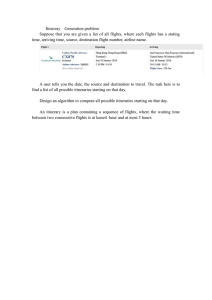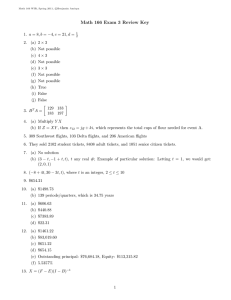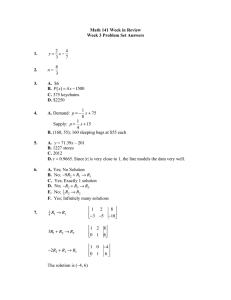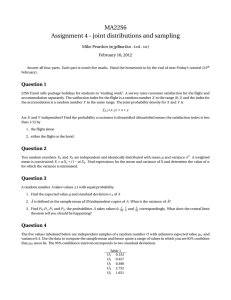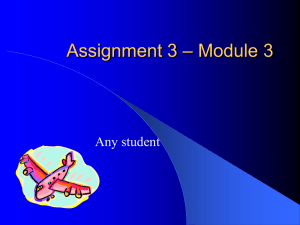An Airline’s Block Time Manipulation Within A Congested Air Traffic Environment NEXTOR
advertisement
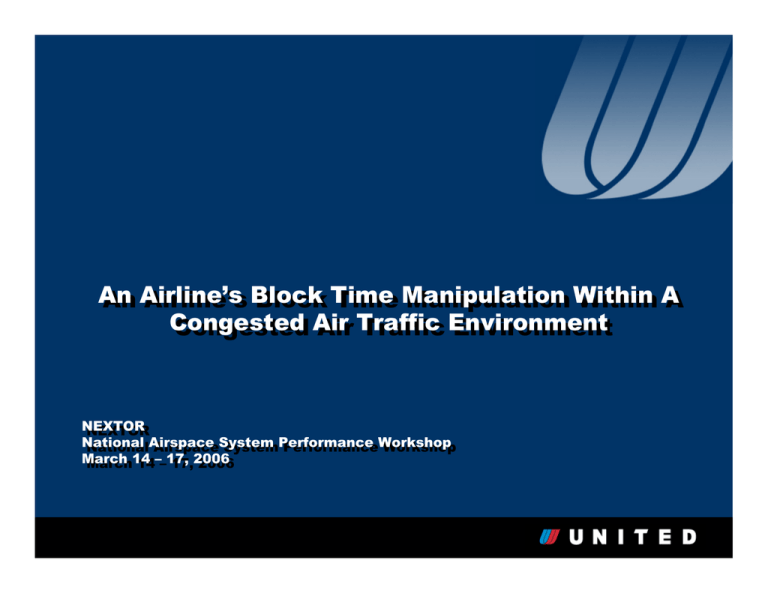
An An Airline’s Airline’s Block Block Time Time Manipulation Manipulation Within Within A A Congested Congested Air Air Traffic Traffic Environment Environment NEXTOR NEXTOR National NationalAirspace AirspaceSystem SystemPerformance PerformanceWorkshop Workshop March 14 – 17, 2006 March 14 – 17, 2006 Topics Topics of of Discussion Discussion • Building Scheduled Block Time For Reliability • The Impact of Increased Congestion • Modernization Efforts Which Help To Reduce Delays • Reducing Scheduling Variability and Cost Through Improved Planning Processes • Summary Building Building Block Block For For Reliability Reliability Development Development Of Of An An Accurate Accurate Scheduled Scheduled Block Block Time Time Is Is Critical Critical For For Maintaining Maintaining An An OnOntime time Airline Airline • Block time is the time from gate departure (brake release) to gate arrival (brake set). It is composed of: - Taxi-out time - Flight time - Taxi-in time • Scheduled block times are calculated to achieve a target block ontime :00 for a season. They are based on the historical performance of a segment when data is available. Page 1 The The Building Building “Block” “Block” of of United’s United’s Operation Operation Begins the long term planning process … How many Pilots do we need? How many Flight Attendants do we need? Estimated Block Time Level (Used in estimating 1 - 2 years out) How will the banks flow? Do we have enough aircraft to maintain the schedule? … And Is Managed Throughout The Aircraft Scheduling Process 5 months or more 4 months 3 months 1 to 2 months Typical schedule development timeline OA creates scheduled block times Intermediate scheduling assigns fleets Current scheduling works in division criteria Further Block Revision Occurs Based On Bank Structure and Position of Flights Within Banks Flight and Onboard crews scheduled Schedule Effective The The Impact Impact of of Increased Increased Congestion Congestion Stronger Stronger Passenger Passenger Demand Demand And And The The Industries Industries Tendency Tendency To To Answer Answer These These Demands Demands With With Smaller Smaller Aircraft Aircraft Has Has Resulted Resulted In In A A Large Large Increase Increase In In Departures Departures Over Over The The Past Past Few Few Years Years Airline Industry Average Daily Departures By Year 8% Increase 18,075 17,894 17,858 17,533 17,520 1995 To 1997 Averaged 16,605 Per Day 16,940 16,654 16,717 16,493 16,446 1995 16,390 1996 1997 1998 Note: Departures are from DOT 32 airports 1999 2000 2001 2002 2003 2004 2005 The The Increase Increase In In Departures Departures Has Has Contributed Contributed To To United United Experiencing Experiencing A A Higher Higher Level Level Of Of Taxi-Out Taxi-Out Times Times United Airline’s Average Taxi-Out Time Per Flight 13% increase 18.9 18.5 17.6 16.9 17.4 16.7 16.6 2001 2002 15.6 14.8 1995-97 Average 1998 1999 2000 2003 2004 2005 Comparing Comparing Similar Similar City City Pairs Pairs With With Similar Similar Fleet Fleet Types, Types, United United Has Has Experienced Experienced A A :02 :02 Minute Minute In In Increase Increase In In Flight Flight Times. Times. In In Denver-Chicago, Denver-Chicago, Flight Flight Times Times Have Have Increased Increased :05 :05 Minutes Minutes Average DEN-ORD B777 Flight Time 1:52 1:47 1995-1997 2004 - 2005 ~5 minute increase While While The The Percent Percent Of Of United’s United’s Overall Overall Flow Flow Control Control Delays Delays Have Have Remained Remained Constant Constant … … United Airline’s Flow Control Delays At The Gate (Percent of Flights) 3.5% 2.5% 2.8% 2.5% 2.8% 2.6% 3.1% 2.4% 1.7% 1995 1996 1997 1998 1999 2000 2001 2002 2.4% 2.1% 2003 2004 2005 .. .. .. The The Intensity Intensity Of Of The The Average Average Flow Flow Control Control Gate Gate Delay Delay Has Has Increased Increased United Airline’s Average Length Per Delay And Flow Control Delays At The Gate (Percent of Flights) 49.4 1995 To 1997 Averaged 34 Minutes Per EDCT 36.8 46.4 43.5 42.8 42.0 ~12 minute increase 30.2 3.5% 2.5% 45.7 42.7 35.2 2.8% 51.2 2.5% 2.6% 1998 1999 2.8% 3.1% 2.4% 2.6% 2002 2003 2.4% 1.7% 1995 1996 1997 2000 2001 2004 2005 Air Air Traffic Traffic Delays Delays Have Have Created Created Significant Significant Cost Cost for for United United Examples of Congestion Cost – Mid-1990s to present Impact on United 3.7 Minutes of increase in taxi out time per Flight $62.8 Million 2 minute increase in route time per flight $52.6 Million 12 minute increase in flow control gate delay (based on 2.5% of Flights Per Day) $4.2 Million $119 million of increased costs NOTE: Costs Based on ATA Numbers; Gate Delay = $24, Taxi-out Delay = $31 and Enroute Delay = $48 Modernization Modernization Efforts Efforts Which Which Helps Helps To To Reduce Reduce Delays Delays Although Although Technology Technology Enhancements Enhancements Help, Help, Runways Runways Remain Remain the the Most Most Effective Effective Capacity Capacity Enhancement Enhancement Estimated Percent Planned Capacity Improvement (VFR Day) Based On The FAA’s Capacity Benchmark Study Planned Runway Capacity 5 31 Atlanta 5 35 Houston 4 29 Minneapolis 40 O’Hare* Los Angeles Technology Enabled Capacity 6 11 none none San Francisco none 27% average increase 6% average increase Short Short Term Term Technical Technical and and Procedural Procedural Changes Changes Will Will Also Also Help Help • SOIR – Simultaneous Operations on Intersecting Runway Operations at ORD: – Increases runway arrival capacity • SOIA – Simultaneous Offset Instrument Approaches at SFO*: – Allows dual runway operations in IFR conditions • Idle descent - Working with DEN and ORD centers and TRACONs: – Optimal descent at flight idle saves fuel and environment * 10-15% of operating days will benefit from SOIA/PRM Reducing Reducing Scheduling Scheduling Variability Variability And And Cost Cost Through Through Improved Improved Planning Planning Processes Processes Increasing Increasing The The Number Number Of Of Block Block Seasons Seasons Over Over The The Past Past Two Two Years, Years, B:00 B:00 Trends Trends By By Month Month Have Have Shown Shown Similar Similar Patterns Patterns During During The The Winter Winter 22 And And Summer Summer 11 Seasons Seasons Winter 2 (Jan-Apr): Between Jan and Apr, B:00 tends to increase as winter head winds diminish 75.0% B:00 OT Percent 70.0% 2006 65.0% 2005 60.0% 2004 Summer 1 (May-Aug): Typically experience a drop in May and then a gradual increase over the summer 55.0% Dec Nov Oct Sep Aug Jul Jun May Apr Mar Feb Jan 50.0% Current Seasonal Breakdown: Winter 2 Summer 1 Fall Winter 1 To To Understand Understand The The Impact Impact Of Of Block Block Seasons Seasons On On Overall Overall Performance, Performance, We We Trended Trended Out Out The The Following Following City City Pairs Pairs B737 – Omni Directional ABQ-DEN DEN-DFW DEN-MCI DEN-MSP DEN-OMA DFW-ORD (N/S) MSP-ORD (N/S) ORD-CMH ORD-LGA SEA-SFO (N/S) SFO-LAX (N/S) SLC-DEN (N/S) = North/South City Pair A320 – Omni Directional LAX-MCO LAX-ORD ORD-DCA ORD-LGA SAN-ORD SEA-ORD SFO-LAX (N/S) SFO-ORD SFO-SAN (N/S) B757 – Omni Directional DEN-LGA DEN-ORD LAX-ORD ORD-BWI PDX-ORD SEA-ORD SFO-EWR SFO-LAX (N/S) SNA-ORD Based Based on on These These City City Pairs, Pairs, Each Each Month Month Tends Tends To To Vary Vary From From The The Annual Annual Average Average In In Terms Terms Of Of Flying Flying Time Time And And Taxi-out Taxi-out Time Time Flight Time (Monthly Variance) - East Bound B737 - East 10.0 B757 - East Taxi-out (Monthly Variance) - West Bound A320 - East B737 - West 10.0 8.0 B757 - West A320 - West 8.0 6.0 Minute Variance Convective Weather 4.0 2.0 0.0 -2.0 -4.0 6.0 Convective Weather 4.0 2.0 0.0 -2.0 -4.0 Dec Nov Oct Sep Aug Jul Jun May Apr Mar Dec Nov Oct Sep Aug Jul Jun May Apr Mar -10.0 Feb -8.0 -10.0 Feb -6.0 -8.0 Jan -6.0 Jan Minute Variance Dec Jan Dec Nov Oct Sep Aug Jul Jun May Apr Mar Feb Jan Taxi-out (Monthly Variance) - East Bound Nov -8.0 -10.0 Oct -6.0 Sep -4.0 Aug 0.0 -2.0 Jul 2.0 A320 - West (Head Wind Impact) 10.0 8.0 6.0 4.0 2.0 0.0 -2.0 -4.0 -6.0 -8.0 -10.0 Jun Minute Variance 4.0 B757 - West May (Tail Wind Impact) 6.0 Minute Variance B737 - West Apr 8.0 Flight Time (Monthly Variance) - West Bound A320 - East Mar 10.0 B757 - East Feb B737 - East Block Minute Variance From Annual Average By By Combining Combining Both Both Directions Directions Along Along With With Actual Actual Flight Flight Time Time Variance Variance and and Actual Actual Taxi-out Taxi-out Variance, Variance, The The Trend Trend Below Below Illustrates Illustrates The The Monthly Monthly Overall Overall Variance Variance From From The The Annual Annual Average (Minute Variance Variance From From Annual Annual Average) Average) Average (Minute 1.0 0.8 0.6 0.4 0.2 0.0 -0.2 -0.4 Larger Variation Has Resulted In Shorter Block Seasons Smaller Variation Has Resulted In Longer Block Seasons -0.6 -0.8 -1.0 Jan Feb Mar Winter 2 Apr May Jun Jul Summer 1 Aug Sep Oct Fall Nov Dec Winter 1 By By Adjusting Adjusting The The Block Block Seasons, Seasons, It It Is Is Possible Possible To To Further Further Minimize (Minute Variance Variance From From Minimize The The Month Month To To Month Month Variation Variation (Minute Block Block Season Season Average) Average) Block Minute Variance From Seasonal Avg 0.5 Wind/Taxi Optimized Season 0.4 0.3 0.2 0.1 0.0 -0.1 -0.2 Current Season -0.3 -0.4 Jan Wind/Taxi Optimized Season: Current Season: Feb Mar Winter 2 Winter 2 Apr Spring May Jun Summer 1 Jul Aug Summer 2 Summer 1 Sep Oct Nov Dec Fall Winter 1 Fall Winter 1 While While The The Wind/Taxi Wind/Taxi Optimized Optimized Seasons Seasons Will Will Impact Impact The The Current Current Aircraft Aircraft Scheduling Scheduling Periods, Periods, Adding Adding A A Spring Spring Season Season Will Will Reduce Reduce Monthly Monthly Variability Variability And And Maintain Maintain The The Aircraft Aircraft Scheduling (Minute Variance Variance From From Block Block Season Season Average) Average) Scheduling Periods Periods (Minute Block Minute Variance From Seasonal Avg 0.5 Schedule Optimized Season 0.4 0.3 0.2 0.1 0.0 -0.1 -0.2 Current Season -0.3 -0.4 Jan Schedule Optimized Season: Current Season: Feb Mar Winter 2 Winter 2 Apr May Spring Jun Jul Aug Summer 1 Summer 1 Sep Oct Nov Dec Fall Winter 1 Fall Winter 1 Next Next Steps: Steps: • Determine the implications of adding an April only and breaking June/July within the Aircraft Scheduling process • Understand the cost of an additional schedule period • Decide to use either the wind/taxi block seasons or the schedule period block seasons • Implement additional seasons Scheduled Scheduled Block Block Time Time Optimization Optimization Based Based On On The The Summer Summer Season Season (May-August), (May-August), Currently Currently 80% 80% Of Of Flights Flights Are Are Within Within +/-:05 +/-:05 Minutes Minutes When When Comparing Comparing Scheduled Scheduled And And Actual Actual Block Block Times Times 140 On 357 Flights, We Could Have Taken At Least 1 Minute Of Scheduled Block Time And Still Achieve A Time At The 65th% … 120 Number of Flights With Exact Scheduled Block and 65th% Time Block 100 Number of Flights … However, We Needed At Least 1 More Minute To Achieve The 65% Time On 509 Flights 80 60 Possible Area For Block Reduction 40 20 0 -16 -14 -12 -10 -8 -6 -4 -2 0 2 4 6 8 10 12 Scheduled Minute Variance From Actual 65th% 14 16 18 20 22 24 Variability Between Flights Allows For Actual Minute Variations From Scheduled While Still Maintaining A B:00 Of 65% For A Given B:00 Performance, Difference Between Scheduled And Actual 65% Can Range Up To 3 or 4 Minutes 100 95 90 85 B:00 % On-Time 80 75 70 65 60 55 50 Variation In Range When Comparing Scheduled Block and Actual 65% Block At B:00 65% 45 40 35 30 25 20 -16 -15 -14 -13 -12 -11 -10 -9 -8 -7 -6 -5 -4 -3 -2 -1 0 1 2 3 4 5 6 7 8 9 10 Scheduled Minute Variance From Actual 65th% Actual Was Less Than Scheduled Actual Was More Than Scheduled 11 12 13 14 15 16 Depending Depending On On Specific Specific City City Pair Pair Congestion, Congestion, A A Given Given Market Market Will Will Have Have A A Completely Completely Different Different Block Block Distribution Distribution When When Compared Compared To To Other Other Markets Markets Denver To Billings – Actual 2005 Block Time Cumulative Distribution 80 60 80% of Flights Fall Within A :15 Minute Period 40 20 0 60 70 80 90 100 110 120 O’Hare To La Guardia – Actual 2005 Block Time Cumulative Distribution Actual Block Minutes 100 Percent of Flights Percent of Flights 100 80 60 40% of Flights Fall Within A :15 Minute Period 40 20 0 100 110 120 130 140 Actual Block Minutes 150 160 Scheduled Scheduled Block Block Time Time Optimization Optimization Became Became Effective Effective With With The The January January Schedule Schedule Change Change And And Has Has Been Been Implemented Implemented Through Through The The Summer Summer Schedule Schedule Period Period Jan 9 – May 3, 2006 May 4 – Sep 5 Sep 6 – Oct 30 Ted Markets Only All Markets Included All Markets Included • O’Hare Inbound Protected • O’Hare Inbound Protected • Recommend ORD Inbound Protection • +/-:05 Minute Change Limit • +/-:03 Minute Change Limit (short haul – less than 5 hours) • +/-:05 Minute Change Limit (short haul – less than 5 hours) • +/-:05 Minute Change Limit (long haul – 5 or more hours) • +/-:10 Minute Change Limit (long haul – 5 or more hours) • No Change to International Tags • No Change to International Tags th • 50 Percentile Lower Bound • 50th Percentile Lower Bound th Schedule Since Since The The January January 99th Schedule Change, Change, Optimization Optimization Has Has Improved Improved Actual Actual B:00, B:00, But But Has Has Only Only Made Made A A Small Small Impact Impact On On Arrival Arrival Performance Performance With Optimization Without Optimization 80.0% Percent of Flights 75.0% 70.0% 67.7% 65.7% 65.0% 60.0% 55.8% 55.0% 54.9% 50.0% Block OT :00 NOTE: Based on actual performance between Jan 9 – Mar 5, 2006 Arrival :00 Flights Flights With With Optimization Optimization Changes Changes Of Of 33 Or Or More More Minutes Minutes Tend Tend To To Have Have The The Largest Largest Impact Impact +/- 1 To 2 Minutes Impact of Block Optimization 3.5% +/- 3 To 5 Minutes 3.3% 3.0% 2.5% 2.0% 1.5% 1.3% 1.0% 0.5% 0.2% 0.3% 0.0% Block OT :00 NOTE: Based on actual performance between Jan 9 – Mar 5, 2006 Arrival :00 Improved Improved Airline Airline Management Management For For Flights Flights Impacted Impacted By By A A Ground Ground Delay Delay Program Program Objective: Objective: Improved Improved EDCT EDCT Compliance Compliance By By Maintaining Maintaining Aircraft Aircraft On On The The Gate Gate ---- Crews Crews Are Are Paid Paid When When Brakes Brakes Released Released Reduced Reduced Fuel Fuel By By Continuing Continuing To To Use Use GPU’s GPU’s Helps Helps To To Reduce Reduce Airport Airport Congestion Congestion Analysis: Analysis: To To Identify Identify The The Impact Impact of of Flow Flow Control Control (FC) (FC) Delays Delays On On Taxi-out Taxi-out Performance Performance -- Included Included All All UAX UAX Flights Flights Arriving Arriving Into Into ORD ORD Between Between 9/05 9/05 –– 2/06 2/06 -- Compared Compared The The Period Period Between Between 9/05-12/05 9/05-12/05 With With 1/06-2/06 1/06-2/06 While While Weather Weather Was Was Better Better Than Than Average Average Over Over The The Past Past Two Two Quarters, Quarters, United United Express Express Flights Flights Still Still Experienced Experienced A A Ground Ground Delay Delay Program Program 10% 10% of of The The Time Time 10% of all flights have "FC" delays GDP impacted flights Regular Flights On On Days Days With With GDP’s, GDP’s, The The Overall Overall Taxi-out Taxi-out Time Time Increases Increases By By 55% 55% For For Flights Flights Arriving Arriving Into Into O’Hare O’Hare Taxi-out increases by 7.8 minutes during GDP days when compared to regular days Minutes Per Flight 25 21.9 20 14.1 15 10 5 0 Taxi-out during GDPs Taxi-out without a GDP Grouping Grouping UAX UAX Stations Stations Into Into 44 Categories Categories Based Based On On The The Taxi-out Taxi-out Difference Difference Between Between “FC” “FC” and and “Non-FC” “Non-FC” Flights Flights (From (From Sept Sept 11 –– Dec Dec 31, 31, 2005) 2005) Incremental Taxi-out Less than 5 minutes Incremental Taxi-out Between 5 and 7.5 mins. Incremental Taxi-out Between 7.5 and 10 mins. Incremental Taxi-out Greater than 10 minutes AVP BNA BOI CAE CLE DTW GSP JAX LAN LNK MLI OKC PIT RAP TVC XNA YWG YYC ABE ATW AUS AZO BHM CAK CID CLT FAR FSD FWA MEM MSP OMA RSW SAT SAV SDF SGF SYR ALB BTV BUF CHS COS CVG DAY DSM GRB ICT LEX MBS MCI MSN PIA RIC SBN SPI ABQ ATL BDL BMI CMH CRW CWA GRR GSO HPN IAH IND MDT MHT MKE MSY MYR ORF PVD PWM, RDU, ROA ROC, STL, TUL TYS, YOW, YUL [ORD inbounds only] If If We We Focus Focus Only Only On On Jan Jan And And Feb Feb 2006 2006 Data, Data, We We See See A A Clear Clear Decrease Decrease In In The The Incremental Incremental Taxi-out Taxi-out Minutes Minutes Incremental Taxi-out Less than 5 minutes Incremental Taxi-out Between 5 and 7.5 mins. Incremental Taxi-out Between 7.5 and 10 mins. Incremental Taxi-out Greater than 10 minutes ABE ATW AVP AZO BNA BTV CAK CLE CLT CRW CVG CWA FSD HPN LAN LEX MBS MLI MSP OKC OMA, PIA, PWM, ROC, SAV, XNA, YEG, YWG, YYC AUS BHM BUF CAE DSM DTW GRB GSP IND JAX LNK MDT MEM MHT MSN PVD RDU ROA SDF SGF YUL ATL BMI CHS CID FAR FWA GRR ICT MCI MKE MSY PIT RIC STL SYR TUL TYS ABQ ALB BDL CMH COS DAY GSO IAH MYR ORF SAT SBN SPI TVC YOW [ORD inbounds only] To To Summarize… Summarize… •• The The Industry Industry Is Is Experiencing Experiencing Increased Increased Traffic Traffic And And Higher Higher Load Load Factors Factors Which Which Limits Limits The The Options Options To To Cancel Cancel Flights Flights •• Modernization Modernization Continues Continues To To Be Be The The Key Key Element Element In In Reducing Reducing Delays Delays By By Increasing Increasing Airport Airport Capacity Capacity •• In In Addition, Addition, Understanding Understanding The The Schedule Schedule Structure Structure And And Options Options Within Within An An Airlines Airlines Control Control Offers Offers Further Further Opportunities Opportunities To To Minimize Minimize Variability Variability
